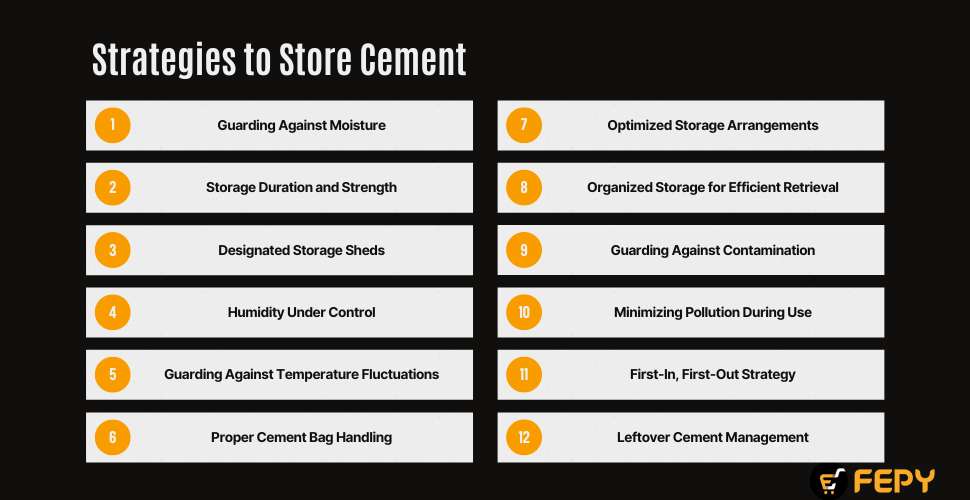How to Store Cement in the UAE: Best Practices You Must Know

Construction relies heavily on cement, but its effectiveness depends on proper storage. Because cement is hygroscopic, meaning it absorbs moisture from the air, it can harden and become unusable if not stored correctly. Here's a breakdown of essential practices to ensure your cement stays fresh and delivers optimal strength for your project.
How to Store Cement: 13 Key Strategies
- Guarding Against Moisture
- Storage Duration and Strength
- Designated Storage Sheds
- Humidity Under Control
- Guarding Against Temperature Fluctuations
- Proper Cement Bag Handling
- Optimized Storage Arrangements
- Organized Storage for Efficient Retrieval
- Guarding Against Contamination
- Minimizing Pollution During Use
- First-In, First-Out Strategy
- Leftover Cement Management
- Monsoon Season Protection

1. Guarding Against Moisture:
Moisture is the enemy of well-stored cement. Even the ambient humidity in the UAE can render cement unusable.
For packaging, airtight bags act as a barrier against moisture absorption. However, finer-grade, high-quality cement absorbs moisture more readily. For these types, prioritize using them fresh and take extra precautions during storage.
A moisture content test is crucial in case of exposure. Cement exceeding 5% moisture content is unsuitable for construction.
2. Storage Duration and Strength:
Time is another factor affecting cement's performance. The longer it's stored, the more its strength diminishes.
When storing cement, ensure that you use it within three months. If storage extends beyond this timeframe, test the cement's strength before incorporating it into your project.
If storage leads to significant strength loss, the cement might not be suitable for structural applications.
However, techniques like vibro grinding can sometimes restore its usability. Vibro grinding enhances the fineness of long-stored cement, potentially making it viable for construction.
3. Designated Storage Sheds:
When designing your shed, consider that one bag of cement typically weighs 50 kilograms, and 20 bags require roughly one cubic meter of storage space. It will help determine the appropriate shed dimensions.
Invest in specially designed storage sheds instead of open-air storage. These structures offer a long-term solution by providing crucial features:
- Waterproof Construction: Build walls, floors, and roofs to resist water, protecting the cement from moisture damage.
- Elevated Floors: The shed floor is positioned well above ground level to minimize moisture exposure further.
- Controlled Ventilation: Strategically placed small windows and airtight doors allow for ventilation while preventing moisture intrusion.
- Efficient Drainage: A well-designed drainage system inside and outside the shed ensures proper water removal and eliminates moisture buildup.
- Easy Access: Select the cement storage area for easy access throughout the construction site. It ensures the smooth transportation of cement to various project locations.
- Clear Pathways: Be mindful of potential obstructions caused by machinery, and prioritize clear pathways for efficient material movement.
4. Humidity Under Control:
Constant vigilance against humidity is critical. Employ humidity sensors or hygrometers to monitor the relative humidity within the storage area.
If readings consistently surpass recommended levels, take action to reduce humidity. Here are two effective strategies:
- Desiccant Packs or Dehumidifiers: These tools actively absorb excess moisture from the air, creating a drier environment for cement storage.
- Silica Gel Packs: These pouches can be placed near cement bags to absorb moisture and maintain a favourable storage climate.
5. Guarding Against Temperature Fluctuations:
Extreme temperature swings can also be detrimental. Use insulating blankets crafted from foam or fibreglass to safeguard the stored cement.
Draping these blankets along walls exposed to harsh winds helps maintain a stable temperature within the shed.
A thermal-resistant curtain or partition system should isolate the cement storage area from the surrounding environment.
6. Proper Cement Bag Handling:
Be careful when handling cement bags. Avoid dropping them or lifting them solely from the ends. Cautious handling of cement bags is essential to prevent damage and potential spills. Here are some key points to remember:
- Avoid Dropping: Dropping bags can compromise the integrity of the packaging and lead to product loss.
- Lifting Techniques: Always lift bags from the sides, never by the ends. Provide support underneath to prevent splitting or sagging.
- Loosening Contents: To minimize splitting during lifting, gently roll the bags over before lifting to reduce the contents slightly.
- Storage Position: When placing bags for storage, ensure the broad side faces downward for optimal stability.
- Safe Handling Practices: Don’t use hooks to lift or stack cement bags. Hooks pose a significant risk of puncturing or tearing the bags, exposing the cement to harmful moisture and dust that can compromise its quality.
- Invest in Proper Handling Tools: Protect your investment and the integrity of your cement by using designated handling tools. Several safe and damage-free options are available. These tools ensure your cement arrives on-site in optimal condition and ready for use.
7. Optimized Storage Arrangements:
Construct a wooden platform raised 150 to 200 millimetres to prevent direct contact with the shed floor. This simple step helps shield the cement bags from moisture that may rise from the ground.
Arrange cement bags in stacks on top of the prepared platform.
Limit each stack to a maximum of 10 bags for enhanced stability.
Maintain a 300-millimetre clearance between the stacks and the shed walls to allow for proper air circulation.
To prevent toppling, employ a cross-stacking arrangement where bag positions are at alternating angles in each layer. This interlocking pattern provides additional stability for the stacks.
Cover all cement stacks with a waterproof layer for long-term protection against moisture and external elements.
8. Organized Storage for Efficient Retrieval:
Maintain a clear passageway of 900 to 1000 millimetres between stacks to facilitate easy access during retrieval.
Ensure each stack contains only the same type of cement, and mark the date of placement on each stack for effective inventory management and to identify older stock that might require strength testing.
9. Guarding Against Contamination:
Never store cement bags alongside other products like fertilizers, as contamination can ruin the cement's quality.
It is also necessary to maintain separate stacks for different types of cement. Always prioritize using the bags opened first to keep a fresh stock rotation.
Avoid storing them near fertilizers or other products that could cause chemical contamination, which could affect the cement's performance.
Maintain separate storage areas for different cement types.
10. Minimizing Pollution During Use:
When cement is used on-site and placed directly on the ground, it may be exposed to various pollutants.
You should re-bag any opened cement in a heavy-duty plastic bag.
Be sure to tightly seal these bags to minimize the risk of pollutants compromising the integrity of the cement.
11. First-In, First-Out Strategy:
Implement a first-in, first-out (FIFO) system for cement usage.
It means prioritizing the oldest bags first. Labelling each stack with the date of receipt simplifies the identification of older stock.
When organizing your cement storage in a warehouse, plan the layout to facilitate the removal of bags in the order they were received.
12. Leftover Cement Management:
Leftover cement requires special attention. Store it in partially used bags and prioritize its use in upcoming projects.
Consider re-bagging them in heavy-duty plastic containers if you have significant excess amounts.
Seal the bag openings securely with duct tape or strong string to prevent tears or punctures.
13. Monsoon Season Protection:
During monsoon season, take extra precautions to shield your cement from moisture.
Completely enclose the stacks with a waterproofing membrane, such as a polyethylene sheet.
Handle the sheet carefully to avoid accidental rips or tears during use.
Ensure proper drainage systems are in place to divert rainwater from the storage area, preventing water accumulation on the floor.
Frequently Asked Questions (FAQs)
What is the ideal storage solution for cement?
Keeping cement away from moisture and heat is critical. A dry, well-ventilated storage area is your best bet.
Why store cement on-site?
Buying cement in bulk can offer significant cost savings. On-site storage eliminates the need for repeated transportation, streamlining your construction process.
How long can cement be stored?
Properly stored cement, shielded from moisture, can last up to three months. Beyond that timeframe, its maximum strength potential may remain the same.
Is using old cement acceptable?
Older cement may not deliver the optimal strength required for construction purposes. Therefore, it is generally recommended that newer stock be prioritized.
What happens if cement and aggregates get wet?
Wet cement is unusable for construction. However, the impact of moisture on aggregates varies depending on the type. If your aggregates get wet, consult with a construction expert for guidance.
Conclusion
High-quality cement translates to more robust, more durable concrete. By extension, this translates to a longer lifespan for your building or structure. Cement storage, as outlined above, safeguards its quality and integrity, ensuring optimal performance in your construction projects.
The good news is that you can now conveniently purchase cement online and in bulk at FEPY! We offer all the top brands at the best prices, delivered directly to you. Store your cement following these best practices, and you'll have the materials you need on hand until your project is complete.
FEPY offers a vast selection of building products from all the leading brands, including UltraTech, RAK Cement, and Arabian Star Cement. You can also compare prices and product specifications for various cement grades.




